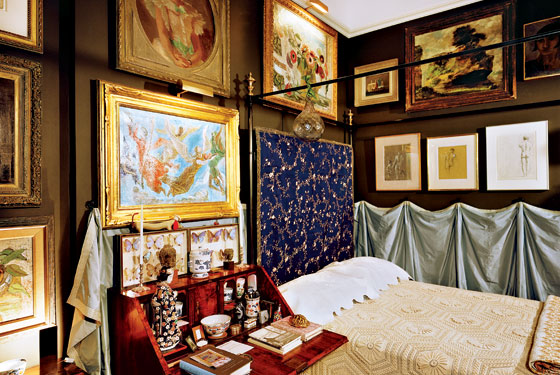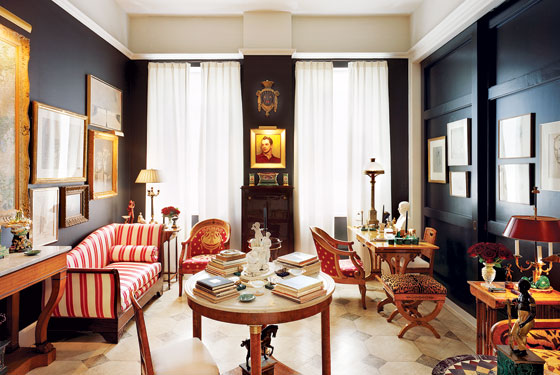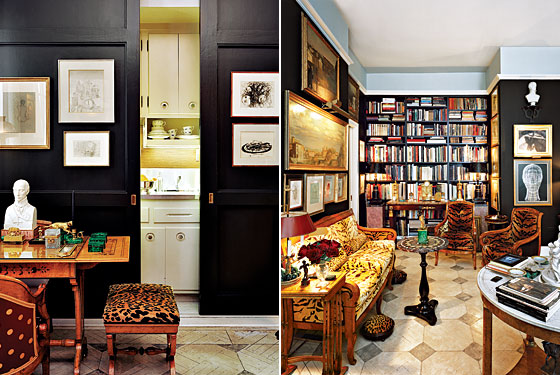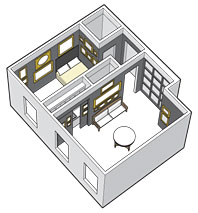
Now, black may not be for everybody, but I think the paintings look better if the walls are dark, because it gives them a chance to shine,” says Richard Lee, explaining the anthracite-dark walls of his one-bedroom in the Osborne, the famously opulent nineteenth-century apartment building diagonally across West 57th Street from Carnegie Hall.
Flattering the artwork is important to Lee, and not just because he’s an interior designer by profession. Lee is an avid painter himself, with an MFA from Carnegie Mellon and an undergraduate degree from the Pennsylvania Academy of the Fine Arts in Philadelphia. Many of the artists now hanging on these dark walls—Julian Levi, Franklin Watkins, Walter Stuempfig, Hobson Pittman—were his teachers: “Mid-twentieth century, very well-known artists who basically were eclipsed by Abstract Expressionism,” he says. Their work (and others he’s added, like a Paul Cadmus drawing of Jared French, and one of Cadmus by French, or a Pavel Tchelitchev painting) needed a proper showcase. To Lee’s mind, that couldn’t be a Soho-minimalist stark white wall. “If you have white walls, it kills the painting,” he says firmly. “You have nothing to contrast.”
Opulent though it seems, with its end-of-the-Empire Charles X furniture and touches of gilding, Lee’s apartment contains a lot of DIY. He painted the walls himself, using a Benjamin Moore mix straight from the can. The marbleized paper that covers the entry was a two-week project involving a T square, an X-acto knife, and book glue. “I thought if I used wallpaper paste, it wasn’t going to absorb,” he explains. “The paper wouldn’t stick to the molding, so I painted it to match.”
The apartment today looks as finished and settled as an old family home that’s been unchanged for decades. But Lee, whose design clients include Paul Simon and Edie Brickell, Costume Institute curator Harold Koda and his partner, the lawyer Alan Kornberg, and Jerome and Mary Kern, is a relentless changer. “I accumulate things, and think, Oh, what would that look like in here? I see a magazine and think, That’s interesting. I want to be a minimalist and have nothing, and yet I love having all the things. So.”

The Sofa
One of a pair, it once belonged to Prince Johannes von Thurn und Taxis. The table is Empire. Lee painted the floor because “it had been sanded so many times, it couldn’t take it anymore.”


The Galley Kitchen
To make the tiny hidden kitchen even sleeker, Lee replaced the original louvers with pocket doors.
The Paintings
Lee particularly likes the era of painting just before Abstract Expressionism. His collection includes works by Walter Stuemfig, Edwin Dickenson, Gray Foy, and Pavel Tchelitchev.
The Living Room
The dark color topped with crisp white was inspired by the British architect Sir Edwin Lutyens, says Lee. The bookshelves hold only half of Lee’s design books; the rest are in storage.
The Furniture
The sofa is Charles X, a period of French furniture from the early nineteenth century. “The two chairs came upholstered this way,” says Lee. The mosaic table is Italian Neoclassical.
The Bed
The headboard cover and wall hanging are from Kay Mertens vintage textiles; she can be found most weekends in the garage at the 26th Street flea market.
The Desk
The pull-down desk is English, ca. 1720. The paintings above it are both by Franklin Watkins.
The Drawings
The left and center drawings over the bed are by John Koch; the third is by Jared French.
